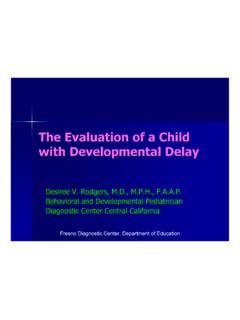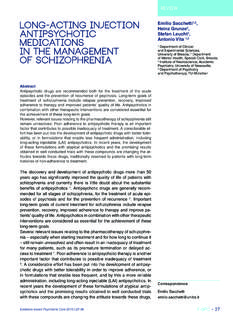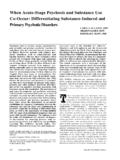Transcription of Overview: Neuropsychological Evaluation of Autistic ...
1 overview : Neuropsychological Evaluation ofAutistic Spectrum DisorderAutistic Spectrum DisorderHoward Glidden, FACPNN europsychological Assessment Neuropsychology is a subspeciality of psychology that blends the disciplines of psychology and neuroscience. APA definition of Pediatric Neuropsychology: Pediatric neuropsychology is a professional APA definition of Pediatric Neuropsychology: Pediatric neuropsychology is a professional specialty concerned with learning and behavior in relationship to a child s brain. A pediatric neuropsychologist is a licensed psychologist with expertise in how learning and behavior are associated with the development of brain structures and Purpose of Pediatric neuropsychology To clarify the diagnosis/differential diagnosis To establish a baseline of functioning To evaluate relative strengths/weaknesses To evaluate change over time To assist in treatment/educational planning To assist in treatment/educational planning To facilitate the therapy itself Psychological/ Neuropsychological evaluations differ from medical classification of brain functions which is usually binary (normal/impaired).
2 Neuropsychological assessment can grade function based on a continuum. Neuropsychological assessment allows for increased principles of assessment No single psychometric test is sufficient or appropriate, by itself, for assessing brain function/dysfunction Assessment, in addition to psychometric test administration, takes into account: Developmental history Developmental history Family history Previous assessments Cultural/language variability Limits of reliability/validity of instruments utilized Test bias There may be many reasons why a client performs poorly on a test or group of tests, which affects reliabilityAll measures, whether they be observation, clinical interview, psychometric or radiologic/lab tests provide estimates of the trait being measure. There are no perfect tests There are no perfect tests Tests are predictive of a trait or attribute being considered Tests yield scores that indicate the degree to which the trait in question is present In general, the higher the score, the greater the amount of the trait being measuredAssessment Guidelines Difficulties:- wide range of functioning (IQ, language, symptom severity)symptom severity)- attention, social, communication, complianceAssessment Guidelines -continued Use the most valid, reliable, and comprehensive measures Parental involvement Parental involvement Coherent view of the child Profile of strengths and weaknesses Contact with other professionalsReliabilityReliability is the degree to which tests scores are consistent, dependable, and repeatable.
3 The greater the error of the test, the lower The greater the error of the test, the lower the is the degree to which a test or measurement accurately measures or reflects what it purports to measure. Validity refers to the tests usefulness in Validity refers to the tests usefulness in measuring the are no valid or invalid test can be reliable, but not be valid. A test cannot be valid, if it s Sensitivity is the probability that a test gives a positive diagnosis, given that the individual actually has the condition for which he or she is being tested. Type I error Type I error Specificity is the probability that a test yields a negative diagnosis, given that the individual does not have the condition for which he or she is being tested. Type II errorType I/Type II tableHISTORICAL PERSPECTIVE 1801 Itard wild boy Mid 1800 s Maudsley insanity in children early 1900 s Bleuler characterized autism as a psychological state associated with detachment with the outside world 1906 Kraeplin dementia praecox DeSantis schizophrenia 1943 Kanner autism 1943 Kanner autism 1944 Asperger Autistic psychopathology 1949 Rank atypical personality development 1952 DSM I - schizophrenic reaction, childhood type 1968 DSM II Schizophrenia, childhood type covered this entire group of disorders 1976 Autism Society of America: working definition of Autism 1978 Rutter 1980 DSM III Distinguishes Infantile Autism (as a category of Pervasive Developmental Disorders) from Schizophrenia, childhood onset 1984 DSM III-R: Highlight Infantile Autism as prototypal Pervasive Developmental Disorder.
4 Provides more specific, developmentally-oriented diagnostic criteria 1994 DSM IV: Attempts to define subtypes of Autistic disorders, including Rett Syndrome, Asperger Syndrome, Atypical Autism, and Pervasive Developmental Disorder NOS DSM V: Stay I (1952)000-x28 Schizophrenic reaction, Childhood Type Here will be classified those schizophrenic reactions occurring before puberty. The clinical picture may differ from schizophrenic reactions occurring in other schizophrenic reactions occurring in other age periods because of the immaturity and plasticity of the patient at the time of onset of the reaction. Psychotic reactions in children, manifesting primarily autism, will be classified II (1968)Autism was not mentioned; the word appears only under the following Schizophrenia , childhood type This category is for cases in which schizophrenic symptoms appear before puberty. This condition may be manifested by Autistic , atypical and withdrawn behavior; failure to develop identity withdrawn behavior; failure to develop identity separate from the mother s; and general unevenness, gross immaturity and inadequacy of development.
5 These developmental defects may result in mental retardation, which should also be III (1980) Diagnostic criteria for Infantile before 30 months of lack of responsiveness to other people (autism) deficits in language deficits in language speech is present, peculiar speech patterns such as immediate and delayed echolalia, metaphorical language, pronoun responses to various aspects of the environment, resistance to change, peculiar interest in or attachments to animate or inanimate objectsF. Absence of delusions, hallucinations, loosening of associations, and incoherence as in SchizophreniaDSM III-R (1987)Diagnostic Criteria for Autistic Disorder At least eight of the following sixteen items are present, these to include at least two items from A, one from B, and one from C. A. Qualitative impairment in reciprocal social interaction (the examples within parentheses are arranged so that those first listed are more likely to apply to younger or more disabled, and the later ones, to older or less disabled) as manifested by the following: lack of awareness of the existence or feelings of others (for example, treats a person as if that person were a piece of furniture; does not notice another person's distress; apparently has no concept of the need of others for privacy); concept of the need of others for privacy); 2.
6 No or abnormal seeking of comfort at times of distress (for example, does not come for comfort even when ill, hurt, or tired; seeks comfort in a stereotyped way, for example, says "cheese, cheese, cheese" whenever hurt); 3. No or impaired imitation (for example, does not wave bye-bye; does not copy parent's domestic activities; mechanical imitation of others' actions out of context); 4. No or abnormal social play (for example, does not actively participate in simple games; refers solitary play activities; involves other children in play only as mechanical aids); and 5. Gross impairment in ability to make peer friendships (for example, no interest in making peer friendships despite interest in making fiends, demonstrates lack of understanding of conventions of social interaction, for example, reads phone book to uninterested peer. DSM III-R continued B. Qualitative impairment in verbal and nonverbal communication and in imaginative activity, (the numbered items are arranged so that those first listed are more likely to apply to younger or more disabled, and the later ones, to older or less disabled) as manifested by the following: 1.)
7 No mode of communication, such as: communicative babbling, facial expression, gesture, mime, or spoken language; 2. Markedly abnormal nonverbal communication, as in the use of eye-to-eye gaze, facial expression, body posture, or gestures to initiate or modulate social interaction (for example, does not anticipate being held, stiffens when held, does not look at the person or smile when making a social approach, being held, stiffens when held, does not look at the person or smile when making a social approach, does not greet parents or visitors, has a fixed stare in social situations); 3. Absence of imaginative activity, such as play-acting of adult roles, fantasy character or animals; lack of interest in stories about imaginary events; 4. Marked abnormalities in the production of speech, including volume, pitch, stress, rate, rhythm, and intonation (for example, monotonous tone, question-like melody, or high pitch); 5. Marked abnormalities in the form or content of speech, including stereotyped and repetitive use of speech (for example, immediate echolalia or mechanical repetition of a television commercial); use of "you" when "I" is meant (for example, using "You want cookie?)
8 " to mean "I want a cookie"); idiosyncratic use of words or phrases (for example, "Go on green riding" to mean "I want to go on the swing"); or frequent irrelevant remarks (for example, starts talking about train schedules during a conversation about ports); and 6. Marked impairment in the ability to initiate or sustain a conversation with others, despite adequate speech (for example, indulging in lengthy monologues on one subject regardless of interjections from others); DSM III-R continued C. Markedly restricted repertoire of activities and interests as manifested by the following: 1. Stereotyped body movements (for example, hand flicking or twisting, spinning, head-banging, complex whole-body movements); 2. Persistent preoccupation with parts of objects (for example, sniffing or smelling objects, repetitive feeling of texture of materials, spinning wheels of toy cars) or attachment to unusual objects (for example, insists on carrying around a piece of string); attachment to unusual objects (for example, insists on carrying around a piece of string); 3.
9 Marked distress over changes in trivial aspects of environment (for example, when a vase is moved from usual position); 4. Unreasonable insistence on following routines in precise detail (for example, insisting that exactly the same route always be followed when shopping); 5. Markedly restricted range of interests and a preoccupation with one narrow interest, , interested only in lining up objects, in amassing facts about meteorology, or in pretending to be a fantasy character. D. Onset during infancy or early childhood Specify if childhood onset (after 36 months of age)DSM-IV-TR Diagnostic Criteria: Autistic Disorder A total of six (or more) items from (1), (2), and (3), with at least two from (1), and one and (3), with at least two from (1), and one each from (2) and (3): DSM-IV-TR Diagnostic Criteria:(1)qualitative impairment in social interaction, as manifested by at least two of the following:(a) marked impairment in the use of multiple nonverbal behaviors, such as eye-to-eye gaze, facial expression, body postures, and such as eye-to-eye gaze, facial expression, body postures, and gestures to regulate social interaction (b) failure to develop peer relationships appropriate to developmental level (c) a lack of spontaneous seeking to share enjoyment, interests, or achievements with other people ( , by a lack of showing, bringing, or pointing out objects of interest) (d) lack of social or emotional reciprocityDSM-IV-TR Diagnostic Criteria: (2) qualitative impairments in communication, as manifested by at least one of the following.
10 (a) delay in, or total lack of, the development of spoken language (not accompanied by an attempt to compensate through alternative modes of communication such as gesture or mime) modes of communication such as gesture or mime) (b) in individuals with adequate speech, marked impairment in the ability to initiate or sustain a conversation with others (c) stereotyped and repetitive use of language or idiosyncratic language (d) lack of varied, spontaneous make-believe play or social imitative play appropriate to developmental levelDSM-IV-TR Diagnostic Criteria: (3) restricted, repetitive, and stereotyped patterns of behavior, interests, and activities as manifested by at least one of the following: (a) encompassing preoccupation with one or more stereotyped and restricted patterns of interest that is abnormal either in intensity or restricted patterns of interest that is abnormal either in intensity or focus (b) apparently inflexible adherence to specific, nonfunctional routines or rituals (c) stereotyped and repetitive motor mannerisms ( , hand or finger flapping or twisting or complex whole-body movements) (d) persistent preoccupation with parts of objectsDSM-IV-TR Diagnostic Criteria: B.







